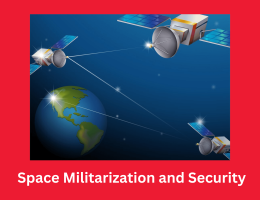
Space Militarization and Security: Navigating the New Frontier of Warfare
- By admin --
- Friday, 08 Mar, 2024
Introduction:
In recent years, space has emerged as a critical domain for military operations, reflecting the increasing reliance on satellite technology for communication, navigation, reconnaissance, and surveillance. The growing importance of space assets for national security and military superiority has prompted nations worldwide to invest heavily in space-based capabilities, leading to concerns about the militarization of space and its implications for global security. This essay examines the dynamics of space militarization, exploring the drivers behind the trend, the challenges it poses, and the potential consequences for international stability.
The Rise of Space Militarization:
Space has long been recognized as a strategic asset for military operations, offering unparalleled advantages in terms of situational awareness, command and control, and precision targeting. Satellites play a crucial role in enabling communication networks, GPS navigation, intelligence gathering, and missile warning systems, providing militaries with the capability to conduct operations with unprecedented speed, accuracy, and efficiency.
The growing reliance on space-based assets for military and civilian purposes has led to the militarization of space, as nations seek to protect and enhance their capabilities in orbit while also developing offensive and defensive space systems to counter potential threats. This trend is driven by several factors, including geopolitical competition, technological advancements, and the increasing vulnerability of space assets to disruption and attack.
Geopolitical Competition:
The strategic significance of space has been accentuated by the intensification of geopolitical competition among major powers, particularly the United States, China, and Russia. These nations view space as a critical arena for asserting their military dominance, safeguarding their national interests, and countering potential adversaries. The development of anti-satellite (ASAT) weapons, space-based surveillance systems, and military satellites reflects their efforts to enhance their space capabilities and protect their assets from potential threats.
Technological Advancements:
Advancements in space technology have significantly expanded the scope and sophistication of military operations in space, enabling nations to develop a wide range of capabilities, including satellite reconnaissance, space-based missile defense, and space situational awareness. Miniaturization, automation, and advances in propulsion systems have made it possible to deploy smaller and more agile satellites, reducing the cost and complexity of space missions while increasing their resilience and survivability.
Vulnerability of Space Assets:
The increasing reliance on space assets for military operations and critical civilian functions has heightened concerns about their vulnerability to disruption, interference, and attack. Satellites are inherently susceptible to a range of threats, including electromagnetic interference, cyber attacks, kinetic weapons, and jamming techniques, which could disrupt communication networks, degrade navigation signals, and impair surveillance capabilities. As a result, nations are investing in measures to enhance the resilience and protection of their space assets, including the development of anti-jamming technologies, hardened satellite architectures, and distributed constellations.
Challenges and Implications:
While space militarization offers significant advantages in terms of enhancing military capabilities and ensuring national security, it also poses several challenges and implications for global stability and security.
Strategic Competition:
The militarization of space has intensified strategic competition among major powers, leading to an arms race in orbit as nations seek to develop and deploy advanced space-based capabilities to gain a competitive edge. This competition increases the risk of miscalculation, escalation, and conflict in space, as rival powers vie for dominance and seek to protect their interests.
Arms Control and Disarmament:
The proliferation of space-based weapons and the absence of international agreements regulating their deployment and use pose challenges for arms control and disarmament efforts. The lack of transparency and confidence-building measures in space increases the risk of misunderstanding and misperception, undermining trust and cooperation among space-faring nations.
Space Debris and Environmental Concerns:
Furthermore, weaponization of space escalates the issue of debris. More specifically, testing and deployment of counter-satellite weapons, as well as other military equipment lead to production of fragments that endanger satellites and vessels placed into orbit. Not only does accumulation of such waste jeopardize space operations but also it evokes anxiety over the future environmental consequences deriving from outer space activities together with possible accidents with active satellites.
Space Governance and Norms:
Enhanced governance mechanisms and international norms are necessary to address the challenges and risks of space activities in the context of a militarized space. To promote transparency, reduce tension and prevent conflict in orbit; it is therefore critical that measures aimed at developing codes of behaviour as well as responsible manners during dealings within Earth’s atmosphere should be instituted()."
Conclusion:
Universally nations depend on space capacities for the military operations and stability. As the nations make this significant turn, they tend to rely more on outer space capacity building than ever before in history. Though the project elevates military capability enhancement leading to protection of strategic advantages, it also brings about obstacles that call for international engagements.





